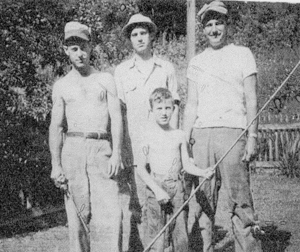WAYNEDALE WOODS AND WATERS

In your last letter, you asked me about hook sizes, how to tell the difference, and how did someone come up with a standardization method? Here is what I have found, after an intensive search through my library of wasted information.
First, there are Wire hooks and Forged hooks. Then we go to: Hook Wire Size – The letter X and the designations “Fine” or “Stout” are used to indicate the weight or diameter of a hook. For example, a 2X Stout means the hook is made of the standard diameter for a hook two sizes larger, and a 3X Stout is made of the standard diameter for a hook three sizes larger. When we go to lightweight hooks, the designations are reversed. For example, a 2X Fine means the hook is made of the standard diameter for a hook two sizes smaller, and so on.
Shank Length – The letter X and the designations Long or Short are used to specify shank length of a hook. The formula for determining shank length is similar to that used for wire sizes. A 2X Long means the shank of the hook is the standard length for a hook two sizes larger, and a 4X Long for a hook four sizes larger. A 2X Short is a hook that has a shank as short as the standard of a hook two sizes smaller, and a 4X Short for a hook four sizes smaller, and so on.
Hook Sizes – Attempts have been made to standardize hook sizes, but none have been very successful. The problem has been that a hook actually has two measurements – the gap and the length of the shank, both of which vary from pattern to pattern.
Hook Parts – The various parts of a hook are: Eye, Shank, Bend, Bite, Spear, Barb, Point, and Gap in that order.
Types and Styles of Hook Parts – They may have a tapered eye, ball eye, looped eye, needle eye, or flatted (hole in flat) eye. They come with ringed hook, eyed hook, turned up tapered eye, turned down tapered eye, turned down ball eye, turned up ball eye, sliced shank, four slice shank, and tipped shank bent back. Next we have a tapered shank, marked shank, marked tapered shank, flatted shank, and a knobbed shank. From there we must look to see if it is a hollow point, curved in point, superior point, Dublin point, or a knife edge point.
Now that we know about the various parts, let’s proceed to: Types and Styles of Hooks. I found: Superior mustad-limerick, hollow point mustad-limerick fly hook turned down tapered eye, superior mustad-sproat fly hook turned down ball eye, hollow point mustad-sproat work hook, superior mustad-carlisle, superior mustad-aberdeen cricket hook, hollow point mustad-wide gap hook, superior mustad-O’Shaugnessy, shank bent aside mustad-central draught, superior mustad-Pacific bass turned down ball eye, mustad-kink shank (hump shank), hollow point mustad-viking fly hook-2X long shank turned down, tapered eye, hollow point mustad-beak turned down tapered eye, hollow point mustad-beak-turned down tapered eye-tow slices in shank, hollow point mustad-beak flounder hook-special long shank, knife edge point mustad-sea hawk, knife edge point mustad-sea demon, knife edge point mustad-southern & tuna hook, mustad-tuna circle hook, mustad-pike hook, mustad-shark hook, hollow point mustad-salmon hook-3X stout, superior mustad-double hook-brazed shank, superior mustad-double hook-loose ringed, hollow point mustad-double hook-universal doublebait, needle-eye, rod attached, and superior mustad-treble hook-sproat bend. Oh, by the way, did you want barbed or barbless hooks?
Now that everything has been cleared up and you know for sure what you need for the type of fishing you’re doing, feel free to use this information to mystify the guy at K-Mart when you buy your next box of fishhooks. As for me, I just dig around in my tackle box “hook mess” until one sticks in my finger that is about the right size to fit either a bee moth or a dough ball. OR . . . you can do as one of my Scouts did on a fall fishing trip/campout at Camp Little Turtle in Northeast Indiana. He took paper clips (no kidding) and cut the wire on an angle so the points would be sharp (he got two hooks per clip). He then took a pair of needle noise pliers and fashioned the eyes. In a few minutes he had made six fishhooks. He borrowed 10 feet of monofilament line, cut a willow pole, scraped away some leaves, found some worms, and caught several bluegills before I even got my pole and reel put together. If you are still having trouble, stop by; I have a whole box of brand new paper clips or if you are brave, you can stick your hand into my tackle box and see what you can come up with. Have you had a Tetanus shot? Good fishes!
Yer ol’ buddy,
Ray
(NOTE: All technical information found in COMPLETE OUTDOORS ENCYCLOPEDIA [an Outdoor Life Book] by Vin T. Sparano {1972} Library of Congress Catalog Card Number 72-90934 SBN 06-013955-2)
MOREL MUSHROOM HUNTING TIPS
As you head to the woods this Spring, try some of these Morel basics that a friend of mine put together.
1. Investigate the “Shapes” – always look 15′-20′ ahead along your path, stay low to the ground and look for the morel “shape” not the mushroom itself.
2. There are three distinct seasons!
a. Blacks – 60-70 degree days with no freezing at night for a week starts the season. They will be smaller if it stays closer to 60 degrees and bigger if the days are closer to 70. More often than not you will find them growing in the woods, NOT around the bases of trees.
b. White’s or Grey’s – 70-80 degree days – look along fences, hedgerows, dying elm, ash or cottonwood trees. These will tend to cluster.
c. Giants – late in the season – The pattern is different each day – A slow warming trend is best. You can go to the same spot 5 days in a row and not see a morel and go on the 6th and there is one there. It takes five years for a spore dropped to the ground to mature.
TIPS: Pinch or cut the mushroom – don’t get dirt in the bag. Always use a mesh bag, never a paper sack etc. This allows the spores to fall to the ground. If you lay the fresh morels on a non-metal screen, off of the ground, in direct sunlight for 4-8 hours they will dry and last forever! (Don’t wash them before you do this). Check out this site for more www.morelheaven.com/
- Celebrating 20 Years Of Community At The Stand - April 12, 2024
- First Positive Case Of Chronic Wasting Disease In Indiana - April 12, 2024
- Southwest Allen County Schools Embark On Major Tree Plantings - April 12, 2024


